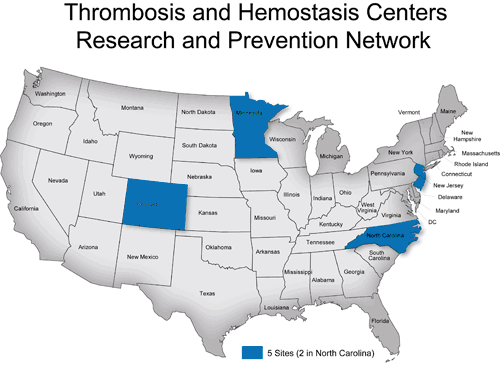Research and Treatment Centers
CDC has provided support to the Thrombosis and Hemostasis Centers Research and Prevention Network to foster collaborative epidemiologic research. This research was designed to identify risk factors for deep vein thrombosis and pulmonary embolism (DVT/PE) among the U.S. population. Findings will ultimately be used to improve the diagnosis and treatment of people who have these conditions. CDC funded five centers, which collect data from patients of all ages and races while providing services to patients who have DVT/PE and other clotting disorders. These centers have multidisciplinary teams of healthcare specialists and state-of-the art clinical research programs that provide outreach and education programs for patients. Below is the contact information for these centers.

Colorado
Hemophilia and Thrombosis Center
University of Colorado Denver
13001 E. 17th Place
Aurora, CO 80045-0507
Phone (303) 724-0365
Website
Minnesota
Mayo Clinic
Coagulation Laboratories and Clinic
200 First Street SW
Rochester, MN 55905
(507) 284-2677
Website
New Jersey
Robert Wood Johnson Medical School Thrombosis Center
Clinical Academic Building
125 Paterson Street
New Brunswick, NJ 08903
Phone: (732) 235-7223
Website
North Carolina
Hemostasis and Thrombosis Center
Duke University Health System
Box 3422
Room 0563 Stead Building
Durham, NC 27710
Phone: (919) 684-5350
Website
Hemophilia and Thrombosis Center
University of North Carolina School of Medicine
CB 7016
Chapel Hill, NC 27599
Phone: (919) 966-4736
Website
CDC also supports a network of hemophilia treatment centers, many of which also offer care to people with thrombosis and thrombophilia.
Highlighted Articles
Key Findings: CDC Study Finds People with Blood Clots at Risk of Permanent Work-Related Disability
CDC collaborated on a study of individuals who had participated in two previous Norwegian studies, looking at each participant’s risk of a first-time VTE during 1994-2008. The new study looked at whether or not participants who previously developed a first-time VTE subsequently received a disability pension due to work-related disability.
(Published August 16, 2016)
New Project Findings
CDC project informs efforts to understand and monitor number of people affected by blood clots in US
(Published October 15, 2015)
New Study Findings
Multiple data sources needed for accurate reporting of blood clots after surgery
(Published June 23, 2015)
New VTE Study
Health conditions, hospital characteristics associated with blood clot diagnosis among patients.
(Published June 23, 2015)
New risk factors for VTE
Study explores levels of proteins important in blood clotting as possible new risk factors for VTE
(Published October 15, 2014)
Preventing HA-VTE
VTE is both a public health problem and a preventable patient safety problem.
(Published March 6, 2014)
Use of CT Scans in EDs
Diagnosis of PE associated with and trends in use of CT scans among patients with chest symptoms.
(Published: December 17, 2013)
Are You at Risk for Blood Clots?
Get free tools from the Stop the Clot, Spread the WordTM campaign.
(Published: March 6, 2017)
CDC Challenge Winners
CDC recognized 8 organizations in helping patients prevent healthcare-associated blood clots.
(Published: April 4, 2016)
Learn Signs and Symptoms of DVT
These types of blood clots are preventable and treatable if discovered early.
(Published: March 7, 2016)
Protect Yourself from Blood Clots
If you are currently or recently hospitalized, recovering from surgery, or being treated for cancer, you are at increased risk of developing serious and potentially deadly blood clots.
(Published: October 12, 2015)
Do You Know about Blood Clots and Travel?
Blood clots can be a serious risk for anyone traveling more than four hours.
(Published: March 24, 2014)
Preventing Venous Thromboembolism
(Published: January 7, 2013)
- Page last reviewed: April 6, 2017
- Page last updated: February 24, 2016
- Content source:


 ShareCompartir
ShareCompartir